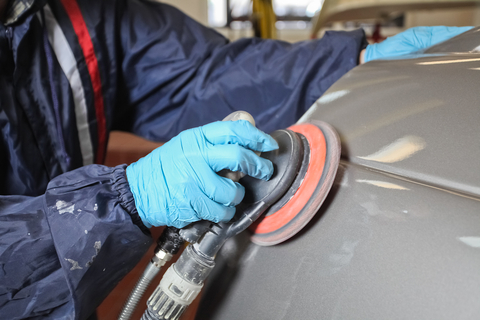To buff-out or re-paint: Answers to paint patch repair

You carefully roll your vehicle into the garage and then hear an odd, scratching sound. A garden tool has scraped across the right front fender, leaving a scrape with missing paint.
What now?
“Just putting touch-up paint on it could potentially make the problem stand out even more,” said Aaron Schulenburg, executive director for the Society of Collision Repair Specialists. “You want to make sure you use the right color and fix it properly to prevent further problems such as corrosion, and a professional collision repair facility can help you determine what the best remedy would be to fix the damage.”
Vehicle manufacturers utilize a two or perhaps three-stage paint process. The difference affects how the damaged area is repaired.
Traditionally, classic vehicles used a “single stage” paint process. The paint was applied over a gray primer and then buffed out for luster.
A two-stage paint process—commonly used since the 1980s—involves covering primer with the base coat paint color and a “clear coat.” The clear coat not only protects the color layer but also provides your vehicle with brilliant shine. Manufacturers often use successive layers of clear coat to enhance the brilliance and depth of the color.
Some colors such as pearlescent white require a “three-stage” process—color paint, pearlescent or metallic paint and a clear coat. The middle layer may contain small flakes of purple, reds, blues or other colors.
“The type of paint process used on your particular vehicle affects how repair of your vehicle’s refinish is accomplished,” Schulenburg said. “There is a big difference between fixing a single minor hood chip that penetrates the clear coat compared to a scrape in the paint that extends into the primer, or an area on your bumper cover where the paint is beginning to peel away.”
A chip may simply require some touch up. A patch of missing or peeling paint may require stripping the part, repainting and even blending the paint into panels that are adjacent to the damaged part so that the refinish will match the rest of the vehicle.
“How to approach the repair is going to vary in each situation and the necessary steps to repair it properly to maintain the look and longevity of your vehicle will be based on the unique characteristics of the damage,” Schulenburg said. “Even environmental factors can play a role such as if you live in a region with snow, salt, ocean air or desert heat. Climate conditions can affect the damaged area and the surfaces around it if not properly treated.”
Schulenburg had the following recommendations and thoughts on fixing damaged paint areas:
- Check with your service advisor or collision repair specialist to discuss repair options. A variety of techniques can make your vehicle look like new again, from simple touch ups or buffing to more extensive refinishing work.
- Does the damaged area show bare metal? This could lead to corrosion and even more expensive repair if not addressed properly in the early stages.
- Older vehicles may be repaired without looking like you put a new cloth on an old garment. Specialists can create custom colors and blend paint into parts adjacent to the damaged panel.
- Look for shops that have auto body accreditation from ASE, and training from iCar or the manufacturer. Another good indication is that the repair facility is a part of its local or national trade association. Look for signs that the shop keeps current with the changing trends in the industry through involvement and training.
- Bumpers are usually made out of plastic composite materials, and colors often appear different than on metal surfaces. As a result, don’t expect paint color to match precisely between the bumper and the fender or quarter panel. Even from the factory, these parts have some slight differences in how they appear.
- For individuals concerned with minor damage caused by normal driving conditions, ask about aftermarket products that can help prevent paint damage. For instance, thin plastic films and add-on covers can help keep road chips from damaging your vehicle’s hood.
“If the paint process is performed by a quality collision repair facility, the repair will match the existing color of your vehicle,” Schulenburg said. “Check with your service advisor or auto body representative. The repair process may be easier than you anticipate.”